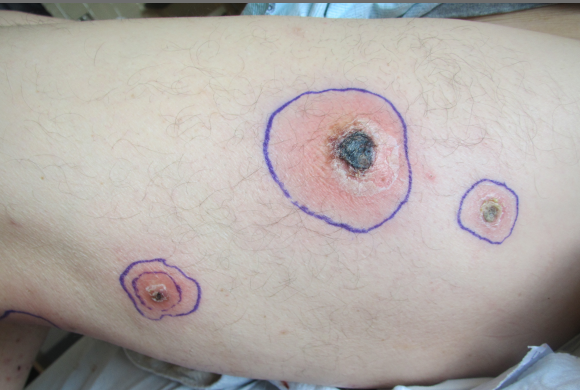Case Presentation: 59 yo Caucasian male presented from an outside hospital (OSH) with primary complaint of “leg abscesses” of 1 wk duration. Patient was afebrile, vital signs stable and in no acute distress complaining of painful “leg abscesses.” PMHx significant for recurrent scrotal cellulitis for the past few years, but was improving when the leg sores appeared. PMHx negative for diabetes, autoimmune conditions, or hospitalization for abscesses. Physical exam unremarkable except for painful eschars 1-4cm in diameter on bilateral lower extremities. Initial labs were unremarkable. General surgery was consulted to I&D the lesions, but US showed no fluid to drain. OSH vancomycin was continued per ID consult recommendations. Blood cultures from OSH and those obtained during this admission showed no growth at 5 days. Wound swabs from both hospitals grew MRSA. Dermatology was consulted and obtained tissue sample of the wounds. Due to rapid appearance of eschars of unclear etiology, Immunology was consulted for possible immunodeficiency. Quantitative serum IgM was low at 11mg/dL (ref range: 40-230) with IgG, IgA, and IgE normal. Repeat IgM level was significantly low at 12mg/dL. ABO typing showed patient was B+, thus isohemogglutinins were ordered. This patient had undetectable Anti-A2 (<1:2) and deficient levels of Anti-A1 (1:2) IgM with expected Anti-B (<1:2) (ref ranges: after 6-9 months of age, titers ≥ 1:4 are considered normal in ABO O patients and <1:2 in AB pts). All other immunodeficiency labs were negative. Patient received vancomycin for 10 days and eschars improved. He was discharged home on doxycycline with Immunology and Dermatology follow-up appointments.
Discussion: Selective IgM Deficiency (SIGMD) is a rare immunodeficiency in which patients have normal T-cell immunity, produce normal levels of IgG and IgA, but produce IgM 2 SD below the mean. This can predispose patients to unusual or recurrent infections. However, patients may be asymptomatic. It is detected by low IgM levels and low isohemogglutinins titers (predominantly IgM isohemogglutinins produced in patients with A or B blood). Our patient has low IgM levels and does not produce adequate levels of Anti-A immunoglobins for his blood type. We report a case of SIGMD in an adult who primarily presented with multiple bilateral lower extremity eschars.
Conclusions: Here we present a rare case of MRSA eschars and chronic skin infections due to SIGMD. To date, there are no reported cases of SIGMD presenting as diffuse eschars. Abnormal MRSA skin presentations in a healthy adult should trigger further investigation for underlying diseases, including primary immunodeficiencies. We are reporting this case to increase awareness among clinicians to consider Selective IgM Deficiency in patients with recurrent or unusual skin infections.

